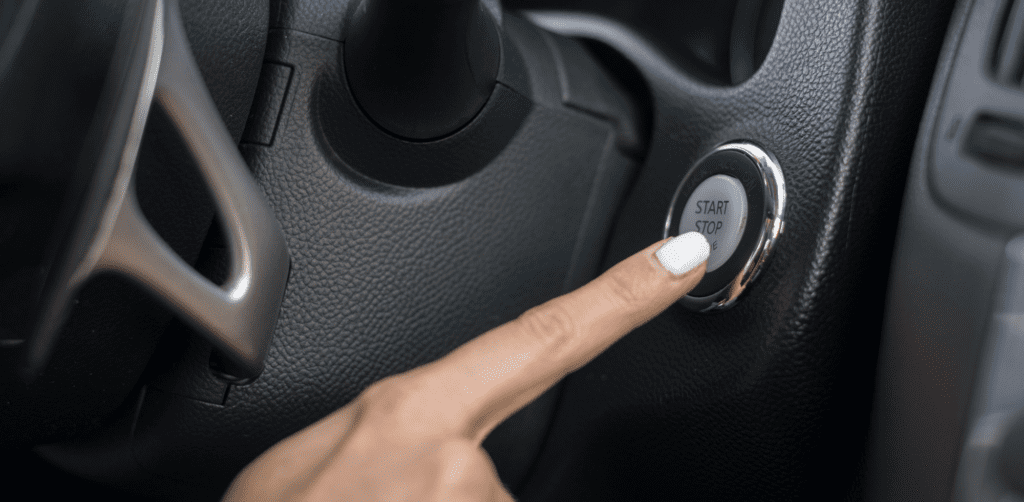Compare cheap car insurance
✔ Compare cheap car insurance quotes
✔ Over 110 insurance providers
✔ Get a quote in minutes
✔ Save up to £504*


Keyless cars offer convenience, but also opportunities for tech-savvy car thieves. With the right tools, criminals can intercept wireless signals, clone digital keys, and drive off in seconds.
But don’t panic. You can outsmart these sneaky thieves and keep your wheels safe. This guide will explain how keyless theft happens, which cars are vulnerable, and most importantly, how to prevent it.
- What is keyless car theft?
- The surge of keyless car theft in the UK
- The different kinds of keyless car theft
- Which cars are vulnerable to keyless car theft?
- How to prevent keyless car theft
- Frequently asked questions
We’ll explore simple solutions like signal-blocking pouches and Faraday cages to stop remote access. Plus tips on disabling wireless entry, using steering wheel locks, and parking strategically.
With a few precautionary steps, you can stay one step ahead and keep your keyless car safely in your hands. Tech not getting the best of you. Read on to take control against high-tech car theft!
What is keyless car theft?
Keyless vehicle theft, also referred to as ‘relay theft,’ is a method used by criminals to steal cars or valuables from inside cars using wireless keyless entry systems.
By intercepting signals between key fobs and vehicles, thieves can trick the vehicle into unlocking without having the actual key.
Typically, criminals purchase the necessary technology online and work in pairs using relay devices to amplify the key fob’s signal, fooling the vehicle’s system into believing the key is nearby and enabling access.
This can allow a vehicle to be accessed and driven away quickly, sometimes in just seconds.
Fortunately, there are precautions vehicle owners can take to protect against keyless theft.
Proactive measures like signal-blocking pouches, Faraday cages, disabling wireless entry, using steering wheel locks, and strategic parking can help thwart these tech-savvy criminals.
How much can you save on your car insurance?
The surge of keyless car theft in the UK
The UK has been witnessing a growing tide of keyless car thefts, with statistics painting a rather disconcerting picture. A comprehensive report unveiled in the summer of 2022 unravels the extent of this menace:
Between April 2021 and March 2022 in England and Wales, a staggering 108,542 vehicles were reported stolen.
In an alarming revelation, vehicles with keyless entry systems were found to be twice as susceptible to theft compared to their traditional counterparts.
Ford Fiesta and Land Rover Range Rover emerged as the most coveted targets among thieves, with 5,979 and 5,533 units stolen in 2022, respectively.
A year-on-year analysis from September 2021 to 2022 presented an unsettling trend – a sharp rise of 29% in car thefts. This translates to an overwhelming number of over 72,000 vehicles being stolen within this window.
Delving into the backdrop, before this issue snowballed in the UK, the European Automobile Association (ADAC) had initiated a probe into the safety metrics of keyless vehicles. Their findings were revelatory, with virtually all vehicles (bar three) out of the 300 assessed proving vulnerable to unauthorised access and ignition.


Piecing together the results from ADAC’s examination and the escalating UK theft rates, a glaring chasm becomes evident. There seems to be a disconnect between keyless vehicle users, car manufacturers, and a comprehensive understanding of the intricate tactics employed in vehicle thefts.
How much can you save on your car insurance?
The different kinds of keyless car theft
In order to effectively prevent keyless vehicle theft, it is important to understand the primary techniques used by criminals. The main methods include:
Hacking
While not widespread currently, smartphone apps create a risk since they allow owners to unlock vehicles remotely. Hackers could potentially access an app using stolen login credentials or exploit vulnerabilities in digital key-sharing platforms. Using strong unique passwords and two-factor authentication is recommended.
Signal Relaying
Keyless entry systems rely on short-range signals, usually 1.8 to 2.7 metres between the fob and the vehicle. Thieves use relay devices to intercept the fob signal from inside the owner’s home, amplify it, and transmit it to an accomplice near the vehicle. This tricks the vehicle into thinking the key fob is present and unlocking.
Close Proximity Testing
Many keyless fob owners are unaware that fobs left on tables or shelves near doors and windows may still be within range of the vehicle. While the fob may be required in the vehicle to start the engine, proximity still allows easy access for theft of valuables. Keeping fobs far from doors and windows is advised.
Key Reprogramming
Modern vehicles contain diagnostic ports that mechanics utilise to access computer systems. Criminals use devices that connect to this port and can quickly program blank fobs or unlock doors. Using a lock on the diagnostic port when not in use by a trusted mechanic is recommended.
How much can you save on your car insurance?
Which cars are vulnerable to keyless car theft?
Virtually any vehicle equipped with keyless entry technology could potentially be vulnerable to theft. It is estimated approximately 94% of vehicles stolen in the UK have keyless systems. Therefore, if a keyless vehicle does not have adequate security features enabled, the risk of theft is significant.
Organisations such as Thatcham Research conduct testing to rate vehicle security, including vulnerability to wireless relay attacks. They collaborate with automotive manufacturers, law enforcement, and insurance providers to identify issues with emerging technologies and mitigate risks.


Some manufacturers are actively addressing the problem, with brands such as:
- Audi
- BMW
- Ford
- Jaguar
- Porsche
- Volkswagen
Introducing new technologies to enhance keyless vehicle security against relay attacks.
While technological advances provide convenience and improvements to daily life, it is critical that consumers remain informed and vigilant against criminal exploitation of those same technologies. Taking appropriate precautions and utilising available security features can help reduce the risk.
Although keyless systems provide ease-of-use benefits, all owners share a responsibility to educate themselves and implement appropriate safeguards to maximise theft prevention. Working together with industry experts and manufacturers will continue to improve keyless vehicle security overall.
How much can you save on your car insurance?
How to prevent keyless car theft
With the growing sophistication of vehicle theft methods, particularly keyless car theft, it’s imperative to understand the risks and adopt effective countermeasures.


The UK theft landscape has been evolving, and armed with the knowledge of criminal tactics, you can better secure your vehicle. Consider implementing the following tips and strategies to fortify your keyless car’s safety.
The Street-side Dilemma
Whenever feasible, keep your car away from the street at night. The Office of National Statistics data suggests that the majority of vehicle-related thefts transpire between 6pm and 6am. If off-street parking isn’t an option, ensure that your car interior is devoid of tempting valuables and apply as many of these precautionary tips as feasible.


Leverage Tracking Technology
Equip your car with a state-of-the-art tracking device. This will not only notify you of any breach attempts but also aid law enforcement agencies in swiftly locating stolen cars, making the apprehension of culprits more efficient.
Lock Verification
In the bustle of daily life, always remember to double-check your car’s lock status. A momentary lapse in attention can lead to unwanted vulnerabilities.
Opt for Fobs with Sleep Modes
Select keyless systems where the fob comes with enhanced security features, such as motion sensors that activate sleep mode after a period of inactivity. This sleep mode renders it unresponsive to external relay signals, thus increasing its security. Familiarise yourself with the fob’s sleep mode activation timings as it varies across models.
Manage Your Keyless Signal
Certain models permit the deactivation of the fob’s wireless signal when not in use. Refer to the user manual or the manufacturer’s digital resources to grasp this feature’s specifics. Mobile phones serving as keys should be managed with the same diligence.
Invest in Signal Interception Accessories
Consider acquiring a signal-blocking pouch or Faraday bag to disrupt potential relay box signals aimed at unauthorised vehicle access. Regularly test the efficacy of these accessories to ensure optimum protection.
Strategic Key Placement
Ensure your keys are positioned away from doors and windows. Depending on where your car is parked, place the keys on the opposite side of your house.
Safeguard Your Spare Keys
Your spare keys deserve equal attention. Store them in a secure, signal-blocking location.
Visible Deterrents
While keyless systems are synonymous with convenience, using additional physical barriers, like steering wheel locks or wheel clamps, can deter potential thieves. These visible deterrents not only slow down theft attempts but also push criminals to look for easier targets.
Fortify Home Security
Augment your home’s security apparatus with advanced features like motion-activated lights, CCTV cameras, and smart doorbell systems. Physical barriers, such as driveway posts, can also add an extra layer of protection.


Defensive Parking Strategy
For households with multiple vehicles, position the less valuable car in a manner that obstructs access to the pricier vehicle. While not foolproof, it can be an effective deterrent.
Reprogram Your Keys
If your car has a previous owner or you’ve misplaced your keys at some point, consider having them reprogrammed for enhanced security.
Stay Updated with Technological Advances
Adopt measures like installing a secure cap over the onboard diagnostic port to thwart theft attempts. Furthermore, regularly update your car’s onboard software to benefit from the latest security enhancements introduced by manufacturers.
Lastly, equip your car with a GPS tracking system. In the unfortunate event of theft, this will greatly aid in the vehicle’s retrieval.
How much can you save on your car insurance?
Frequently asked questions
In order for criminals to successfully conduct a wireless relay theft attack on a keyless vehicle, they need only be in relatively close proximity to the key fob. Typically within a range of approximately 2 to 3 meters (6 to 10 feet). This allows them to intercept the key’s wireless signal and unlock or access the vehicle.
Even if the vehicle requires the physical key fob to be present to start the engine, proximity still enables thieves to unlock doors and access vehicle interiors.
Therefore, it is strongly advised that keyless fob owners maintain substantially more than 10 feet of distance from exterior doors and windows. Storage options like key hooks placed deep within homes, kitchen drawers, or secured lock boxes are recommended.
Additionally, Faraday bags or pouches that block wireless signals can provide an extra layer of protection when not in use.
Knowledgeable keyless vehicle owners can proactively keep key fobs well outside the range of would-be thieves, mitigating the risk of relay theft attacks. Small preventative steps can make a major difference in security.
To safeguard against keyless car theft through signal relay tactics, it’s advised to position your keys at a distance from front doors, windows, or any external walls, as these are common points of access for criminals.
Additionally, for enhanced protection, consider storing your key fob in a metal container or a specially designed signal-blocking pouch, often referred to as a Faraday pouch.
These containers act as barriers, disrupting the key’s signal and making it harder for thieves to intercept and replicate.
Another useful tip is to routinely check the effectiveness of your chosen pouch or container, ensuring it’s still efficient at blocking signals over time.
Unfortunately, with the appropriate technical knowledge, criminals could potentially drive a stolen keyless vehicle an unlimited distance until stopped by a lack of fuel or being turned off.
Many keyless vehicles today do not require a physical key fob to be present in order to start or drive. Thieves employing signal relay devices or reprogramming techniques can circumvent this security measure.
While some models may produce audible alerts when a fob is not detected, this does not physically prevent driving the vehicle. Additionally, proximity alone still enables unlocking doors and accessing interiors.
The range of operation depends largely on how quickly GPS tracking or other recovery methods are employed. However, these are not infallible.
The most effective strategy is preventing theft from occurring at all. Measures like Faraday fob storage, steering wheel locks, wheel clamps, and audible alarms can slow efforts and deter criminals considerably.
Knowledgeable owners taking proactive precautions can help minimise this risk, rather than determining how far thieves might drive keyless vehicles without keys present. Advanced planning is critical.
The majority of comprehensive and third-party fire and theft car insurance policies do cover keyless car theft. However, it’s essential for drivers to be aware that possessing a car with keyless entry might result in increased car insurance premiums, especially if the car doesn’t have inherent protections against this kind of theft.
To mitigate potential premium hikes, owners can consider incorporating recognised security features like a tracking system, an efficient car alarm, and a robust steering wheel lock which can act as significant deterrents to would-be thieves.
The susceptibility of a car to keyless theft significantly influences the official vehicle security ratings, a crucial metric that insurance providers rely on when determining premiums.
This has led to a growing push in the automobile industry, urging manufacturers to address these vulnerabilities in their newer models. The aim is to make modern vehicles less attractive to thieves and, consequently, reduce the risk of keyless thefts.
It’s always wise for car owners to consult their specific policy details and liaise with their insurance provider to get clarity on cover related to keyless theft.
